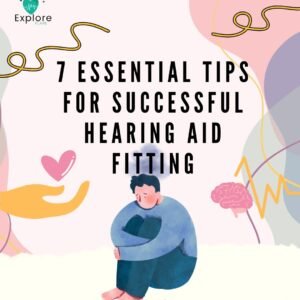7 Essential Tips for Successful Hearing Aid Fitting
Hearing aids can greatly improve of the quality of life for people who have hearing loss. However getting the optimum outcomes from these devices is strongly dependent on appropriate fitting and adjustment. Here are seven key considerations for a successful hearing aid fitting.

1. Consult with a Hearing Aid Fitting
The first and most important step is to speak with an audiologist or hearing specialist before beginning the fitting procedure. They are qualified to evaluate your hearing loss suggest the best hearing aid and offer tailored guidance. The expert will do a comprehensive hearing evaluation during this appointment, which could involve:
- Assessments of the middle ear
- speech discrimination tests
- pure-tone audiometry
This thorough assessment will assist in determining your unique hearing requirements and help you choose the best equipment. Keep in mind that every person has a different hearing loss, so seeking professional advice is crucial for the best outcomes.
2. Choose the Right Hearing Aid Fitting
It might be difficult to choose the best hearing aid fitting among the many that are available. Different kinds including completely-in-canal (CIC) in-the-ear (ITE), and behind-the-ear (BTE) are appropriate for different lifestyles and types of hearing loss. When selecting a hearing aid take into account the following factors:
- Degree of Hearing Loss: While some devices are designed to address significant hearing loss others are more appropriate for milder loss.
- Lifestyle Needs: Long-lasting, perspiration-resistant models may be advantageous for active people.
- Cosmetic Preferences: While some users value usefulness above all else others like alternatives that are more discrete.
Your audiologist can guide you through these options and make sure you choose a gadget that suits your particular needs.
3. Be Patient During the Adjustment Period Hearing Aid Fitting
It may take some time to become used to wearing hearing aids. At first, sounds could feel distorted or magnified, which could be uncomfortable. Your brain requires time to adapt to the additional aural information therefore this is quite normal. Here’s how to make the changeover easier:
- Wear Your Aids Consistently: Try to wear your aids for a few hours every day extending the time as you feel more at ease.
- Practice in Various Environments: Begin in more subdued environments and progressively introduce yourself to increasingly complex noises, like those found in busy streets or restaurants.
- Share Concerns: Do not be afraid to contact your audiologist for adjustments if you are uncomfortable or have ongoing problems.
With practice and patience you will begin to enjoy the advantages of better hearing however the adjustment period may vary.
4. Follow Up for Fine-Tuning Hearing Aid Fitting
Following up with your audiologist on a regular basis is essential for fine-tuning your hearing aids once you’ve started wearing them. These meetings enable modifications in response to your input and experiences. What to anticipate during these appointments:
- Adjusting the volume levels to your preferred degree of comfort is the first step in the process.
- Program Changes: Adjusting the sound parameters for various conditions, including loud locations or quiet chats.
- Ear Molds and Fit Adjustments: Making sure the gadget fits your ear pleasantly and snugly.
These follow-up appointments are necessary to make sure your hearing aids are meeting your changing needs and to maximize their performance.
5. Maintain and Care for Your Hearing Aids Fitting
guaranteeing maximized operation. Here are a few hints to really focus on your gadgets:
- Day to day Cleaning: Wipe off your portable hearing assistants with a delicate dry material consistently checking for earwax development.
- Dampness Protection: Keep your portable hearing assistants dry and consider utilizing a dehumidifier in the event that you live in a moist environment.
- Battery Management: To keep away from unexpected blackouts have reinforcement batteries close by and supplant them consistently.
Keeping up with your listening devices guarantees they perform appropriately and lessens the probability of issues.
6. Educate Yourself on Hearing Aid Fitting Features
the user experience. To get the most out of your smartphone learn about these features:
- Directional Microphones: These allow you to focus on sounds originating from specified directions while eliminating background noise.
- Bluetooth Connectivity: Many hearing aids now include Bluetooth, allowing you to connect to smartphones and other devices for direct audio streaming.
- Noise Reduction: Some models include built-in noise reduction technology to help filter out background noise in difficult listening conditions.
Understanding these characteristics will help you use your hearing aids more successfully and improve your overall listening experience.
7. Join a Support Group or Community Hearing Aid Fitting
Navigating hearing loss can be solitary. Joining a support group or community can provide encouragement and vital information. Engaging with individuals who have had similar experiences allows you to:
- Share Tips and Strategies: Learn from others about how they use and modify their hearing aids.
- Gain Emotional Support: Talk about the problems and joys of life with hearing loss to make you feel less isolated.
- Stay Informed: Get resources and information about new technology, research, and coping strategies.
Many local groups and internet forums exist to help people with hearing loss. Connecting with these groups can improve your experience and give you a sense of belonging.
Conclusion: Hearing Aid Fitting
Successful hearing aid fitting is a multidimensional procedure that necessitates careful planning and collaboration with hearing professionals. By following these seven basic guidelines you can improve your hearing aid experience and overall quality of life. Remember, patience and persistence are essential. With the correct support and tweaks you may truly embrace the sounds of your surroundings.

